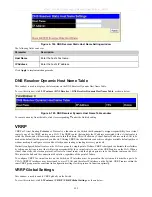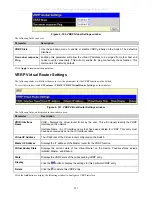
xStack
®
DGS-3600 Series Layer 3 Managed Gigabit Ethernet Switch
sources to determine which single router will send the receiver the necessary multicast data. The source with the shortest metric
(hop count) will be elected as the primary multicast source. This metric value is included within the Assert message.
PIM-DM
The
Protocol Independent Multicast - Dense Mode (PIM-DM) protocol should be used in networks with a low delay (low latency)
and high bandwidth as PIM-DM is optimized to guarantee delivery of multicast packets, not to reduce overhead.
The PIM-DM multicast routing protocol is assumes that all downstream routers want to receive multicast messages and relies
upon explicit prune messages from downstream routers to remove branches from the multicast delivery tree that do not contain
multicast group members.
PIM-DM has no explicit ‘join’ messages. It relies upon periodic flooding of multicast messages to all interfaces and then either
waiting for a timer to expire (the Join/Prune Interval) or for the downstream routers to transmit explicit ‘prune’ messages
indicating that there are no multicast members on their respective branches. PIM-DM then removes these branches (‘prunes’
them) from the multicast delivery tree.
Because a member of a pruned branch of a multicast delivery tree may want to join a multicast delivery group (at some point in
the future), the protocol periodically removes the ‘prune’ information from its database and floods multicast messages to all
interfaces on that branch. The interval for removing ‘prune’ information is the Join/Prune Interval.
PIM-SM-DM
In the PIM-SM, RP is a key point for the first hop of the sender. If the first hop does not have RP information when the sender
sends data out, it will drop the packet and do nothing. Sparse-Dense mode will be useful in this condition. In Sparse-Dense mode,
the packets can be flooded to all the outgoing interfaces and pruning/joining (prune/graft) can be used to control the outgoing
interface list if RP is not found. In other words, the PIM Sparse-Dense mode is treated in either the sparse mode or dense mode of
the operation; it depends on which mode the multicast group operates. When an interface receives multicast traffic, if there is a
known RP for the group, then the current operation mode on the interface is sparse mode, otherwise the current operation mode on
the interface will be dense mode.
PIM Global Settings
This window is used to enable PIM globally on the Switch.
To view this window, click
L3 Features > IP Multicast Routing Protocol > PIM > PIM Global Settings
, as shown below:
Figure 4- 123. PIM Global Settings window
Use the pull-down menu, choose
Enabled
, and click
Apply
to set the PIM function on the Switch.
PIM Parameter Settings
The following window will configure the parameter settings for the PIM distribution tree.
To view this window, click
L3 Features > IP Multicast Routing Protocol > PIM > PIM Parameter Settings
, as shown below:
Figure 4- 124. PIM Parameter Settings window
The following fields can be viewed or set:
Parameter
Description
266
















































